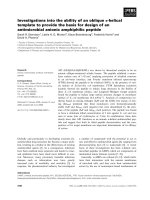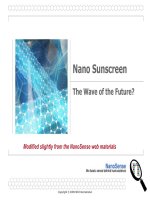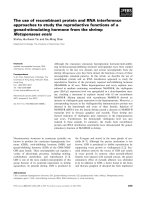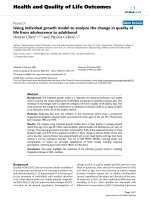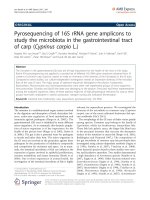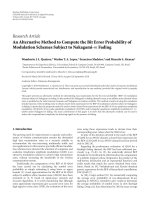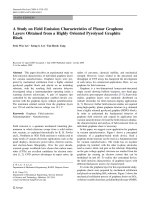To study the osmotic dehydration characteristics of Kiwifruit (Actinidia delicosa) slices
Bạn đang xem bản rút gọn của tài liệu. Xem và tải ngay bản đầy đủ của tài liệu tại đây (469.18 KB, 11 trang )
Int.J.Curr.Microbiol.App.Sci (2018) 7(7): 1931-1941
International Journal of Current Microbiology and Applied Sciences
ISSN: 2319-7706 Volume 7 Number 07 (2018)
Journal homepage:
Original Research Article
/>
To Study the Osmotic Dehydration Characteristics of
Kiwifruit (Actinidia delicosa) Slices
Namneet Kaur1*, Naveet Kaushal1, Ajay Singh2 and Manpreet Kaur1
1
Department of Agriculture, 2Department of Food Technology, Mata Gujri College,
Fatehgarh Sahib, India
*Corresponding author
ABSTRACT
Keywords
kiwifruit,
Temperature,
Concentration, Sugar,
Osmotic dehydration
Article Info
Accepted:
15 June 2018
Available Online:
10 July 2018
Kiwifruit slices were immersed in a solution containing sugar solution of
30, 45 and 60 ᵒ Brix for about 1 h, at three different osmotic solution
temperatures 30, 40 and 50 ᵒ C.The effect of process parameters (such as
duration of osmosis, syrup concentration and syrup temperature) on mass
transport data (such as water loss, solid gain and mass reduction) during
osmotic dehydration was studied. After 1 h of osmotic dehydration, the
minimum and maximum mass reduction, water loss and sugar gain were in
the range of 32.50 to 43.74, 36.30 to 55.82 and 6.88 to 11.82 per cent
corresponding to low levels (30 ᵒ Brix, 30ᵒ C) and high levels (60 ᵒ Brix,
50 ᵒ C) of syrup concentration and temperature respectively.
Introduction
Kiwifruit (Actinidia deliciosa) belongs to
family Actinidiaceae with chromosome no.
(2n) 58. Its primary origin is China and
secondary origin is New Zealand. Area under
cultivation in India is 4000 ha with production
and productivity of 1100 mt and 3mt/ha
(nhb.gov.in 2016-17). It is a temperate fruit
crop. Kiwifruit is also known as Chinese
gooseberry and horticultural wonder of New
Zealand. In India it is cultivated in Himachal
Pardesh. Kiwifruit is known for its flavour and
vitamin C content. It is a climacteric fruit and
is very sensitive to ethylene. Botanically,
kiwifruit is a berry with various locules filled
with many small and soft black seeds. Its flesh
is separated into three regions: the outer
pericarp, the inner pericarp with seeds, and the
columella (core). Each part differs from the
others with respect to composition and texture.
The columella is lighter than the inner and
outer pericarps. Kiwifruit belongs to family
Actinidiaceae and genus Actinidia (Guroo et
al., 2017).
Many researchers have studied osmotic
dehydration of various fruits and vegetables,
such as apple, banana, carrot, cherry, citrus
fruits, guava, mango, etc. (Torreggiani and
1931
Int.J.Curr.Microbiol.App.Sci (2018) 7(7): 1931-1941
Bertolo, 2001). The osmotic dehydration
process has been studied and used as a pretreatment prior to further processing such as
convective-drying (Pisalkar et al., 2011). Very
few attempts have been made to study osmotic
dehydration characteristics of kiwifruit.
Therefore, a study was proposed to investigate
osmotic
dehydration
characteristic
of
kiwifruit.
Osmotic dehydration is one of the less energy
intensive techniques than air or vacuum drying
process because it can be conducted at low or
ambient temperature. It is the process of water
removal by immersing water containing
cellular solids in concentrated aqueous
solution. The driving force for water removal
is the concentration gradient between the
solution and the intracellular fluid. If the
membrane is perfectly semi-permeable, solute
is unable to diffuse through the membrane into
the cell. However, it is difficult to obtain a
perfect semi-permeable membrane in food
systems due to their complex internal structure
and there is always some solid diffusion
process. The water and acid diffuse at faster
rates initially and get reduced at later stage,
while solute from concentrated solution
diffuses in opposite direction. The solute
penetration in food material is less at first, but
increases with respect to time. The solute
(sugar) penetration in the fruit directly affects
the quality i.e. both flavour and taste of the
end product (Kedarnath, et al., 2014).
Materials and Methods
A widely grown fruit kiwifruit (cv Bruno) was
selected for the osmotic dehydration
experiment. Food grade sugar was used as an
osmotic agent being cheap and easily
available. Ripened kiwifruit of uniform size,
colour and firm texture were taken for
experiment. Selected fruits were thoroughly
washed under tap water to remove adhering
impurities before slicing the fruit. The outer
skin of the ripened fruit was carefully peeled
off manually using a sharp stainless steel knife
without damaging the pulp. The peeled
kiwifruit fruits were cut into about 4-5 mm
thick slices for the experiment. Sugar syrups
of various concentrations were prepared by
dissolving required amount of sugar in
distilled water.
Sugar syrup of 30, 45 and 60 ᵒ Brix
concentration was prepared by adding the
required amount of sugar in distilled water and
the total soluble solids of prepared syrup were
determined by hand refractometers of various
ranges (0-32, 28-62 and 58-92 ᵒ Brix). The
moisture content of the fresh as well as
osmotically dehydrated kiwifruit samples was
determined by oven drying at 50 ᵒ C for 9 h
(Ranganna, 2000).
Experiments were conducted at nine
combination of three concentrations (30, 45
and 60 ᵒ Brix) and three temperatures (30, 40
and 50 ᵒ C). The prepared samples (kiwifruit
slices) were weighed approximately 40 g for
every experiment and immersed in the sugar
syrup (30, 45 and 60 ᵒ Brix) contained in a 250
ml glass beaker. The beakers were placed
inside the constant temperature water bath.
The syrup in the beakers was manually stirred
at regular intervals to maintain uniform
temperature. One beaker was removed from
the water bath at designated time and placed
on tissue paper to remove the surface
moisture. The samples were weighed and their
moisture contents were determined. The water
loss and solid gain were calculated based on
mass balance. All the experiments were
replicated thrice and results reported are from
average value of three replications.
Water loss or Mass transfer out
Water loss is the quantity of water lost by food
during osmotic process. The water loss (WL)
is defined as the net weight loss of the fruit on
1932
Int.J.Curr.Microbiol.App.Sci (2018) 7(7): 1931-1941
initial weight basis and is estimated as
follows.
WL = Wi . Xi – WѲ.XѲ
________________
Wi
....(1)
WѲ = mass of slices after time ѳ,g,
Wi = initial mass of slices, g,
XѲ = water content as a fraction of mass of
slices at time Ѳ
Xi = water content as a initial mass of slices,
fraction.
Mass reduction
Results and Discussion
The overall exchange in the solid and liquid of
the sample do affect the final weight of the
sample. The mass reduction (MR) can be
defined as the net weight loss of the fruit on
initial weight basis.
Water loss
MR=
Wi – WѲ
________________
Wi
....(2)
Solid gain or Mass transfer in
The solids from the osmotic solution get
added in the sample of kiwifruit slices during
osmotic dehydration. The loss of water from
the sample takes place in osmotic dehydration
consequently it increases the solid content.
The solid gain is the net uptake of solids by
the kiwifruit slices on initial weight basis. It is
computed using following expression:
SG= WѲ(1-XѲ) – Wi(1- Xi)
________________
× 100 ....(3)
Wi
From Equations (3.2) and (3.3), the solid gain
(SG) can be correlated with mass reduction
(MR) and water loss (WL) as,
The water loss increased from 0 to 36.30,
37.64 and 39.64 per cent when duration of
osmotic dehydration increased from 0 to 1 h
for 30 ᵒ Brix at 30, 40 and 50ᵒ C temperatures
respectively. For 45 ᵒ Brix, the water loss was
found to vary from 0 to 44.10, 47.22, and
47.84 per cent and similarly at 60 ᵒ Brix was
found to vary from 0 to 51.69, 54.04 and
55.82 per cent at 30, 40 and 50ᵒ C
respectively.
Figure 1 revealed that a low temperature - low
concentration condition (30ᵒ C - 30 ᵒ Brix)
resulted in a low water loss (36.30 per cent
after 1 h of osmosis) and a high temp - high
concentration condition (50ᵒ C - 60 ᵒ Brix)
resulted in a higher water loss (55.82 per cent
after 1 h of osmosis). This indicates that water
loss can be increased by either increasing the
syrup temperature or concentration of
solution. Similar results have been reported
for osmotic dehydration of bananas by (Sagar,
2001).
Where,
Figure 2 shows the variation in water loss in
30, 45 and 60 °Brix concentrations at
temperatures 30, 40 and 50°C. The water loss
was found increasing with increasing osmotic
solution concentrations at all the three solution
temperatures i.e. at 30, 40 and 50°C.
WL = water loss ( g per 100g mass of sample),
SG = solid gain (g per 100 g mass of sample)
MR= Mass reduction (g per 100 g mass of
sample),
These findings were in confirmation with the
results obtained. In all the experiments, the
rate of water loss was more in the beginning
of process and decreased gradually with the
SG = WL- MR
... (4)
1933
Int.J.Curr.Microbiol.App.Sci (2018) 7(7): 1931-1941
increase of duration of osmosis and
approaches equilibrium. The similar results
were quoted in case of the osmotic
dehydration of banana slices (Pokharkar and
Prasad, 1997).
Increased water loss with increase in syrup
concentration at a particular temperature of
syrup may be due to increased osmotic
pressure in the syrup at higher concentrations,
which increased the driving force available for
water transport. This is in agreement with
(Nieuwenhuijzen et al., 2001).
Sugar gain
The sugar gain was increased from 0 to 6.88,
7.20 and 7.78 per cent when duration of
osmotic dehydration increased from 0 to 1 h
for 30 °Brix concentration at 30, 40 and 50°C
syrup temperatures respectively. For 45 °Brix
concentration, the sugar gain was found to
vary from 0 to 8.93, 9.32 and 9.93 and for 60
°Brix it varied from 0 to 11.02, 11.45 and
11.82 percent for 30, 40 and 50°C syrup
temperature.
Figure 3 shows that sugar gain increased with
duration of osmosis and approaches the
equilibrium after 1 hour of osmotic
dehydration. The sugar gain also increased
when the concentration of the syrup was
increased. This is because of the increased
concentration difference between samples.
The sugar gain also increased with increase in
syrup temperature. It may be due to collapse
of the cell membrane at higher temperatures.
Similar results have been reported by (Nsonzi
and Ramaswamy, 1998).
Figure 4 shows the variations in sugar gain at
various temperatures at 30, 45 and 60 º Brix
concentrations.
A
low
temperature-low
concentration
condition (30°C -30 °Brix) gives a low sugar
gain (6.88 per cent after 1h of osmosis) and a
high temp-high concentration condition (50°C
-60 °Brix) gives a higher sugar gain (11.82 per
cent after 1 h of osmosis). The low
temperature-high concentration condition
30°C -45 °Brix and 30°C -60°Brix gives a
slightly lower sugar gain of 8.93 and 11.02
after 1 h of osmosis than high temperaturehigh concentration condition 50°C -45 °Brix
and 50°C -60 °Brix as 9.93 and 11.82 per cent
sugar gain after (1 h of osmosis) indicates a
pronounced effect of temperature on sugar
gain.
This indicates that sugar gain can be increased
by either increasing the syrup temperature or
concentration of solution.
However, an increase in temperature of sugar
solution by 10°C has more influence on sugar
gain than an increase in concentration by 15
°Brix, may be because of higher temperature
causes destruction of cell membrane structure.
Similar results have been reported by
(Lazarides et al., 1995) with osmotic
dehydration of apple slices in a temperature
range of 20-50°C.
Mass reduction
The mass reduction after osmotic dehydration
was found to be in the range of 32.50 to 43.74
per cent, corresponding to experiments at low
level (30°Brix, 30°C after 1 h) and at high
level (60 °Brix, 50°C after 1 h) (Fig. 5).
The mass reduction increased from 0 to 32.50,
36.30 and 40.52 percent when duration of
osmotic dehydration increased from 0 to 1 h at
30, 40 and 50°C temperatures respectively for
30°Brix while for 45 °Brix, the mass reduction
was found to vary from 0 to 33.13, 38.27 and
42.63 per cent and for 60°Brix from 0 to
34.74, 40.46 and 43.74 per cent at 30, 40 and
50°C respectively.
1934
Int.J.Curr.Microbiol.App.Sci (2018) 7(7): 1931-1941
Fig.1 Variation in water loss with sugar syrup concentration at 30, 40 and 50 ᵒ C temperature
1935
Int.J.Curr.Microbiol.App.Sci (2018) 7(7): 1931-1941
Fig.2 Variation in water loss with temperature at 30, 45 and 60 ᵒ Brix concentration
1936
Int.J.Curr.Microbiol.App.Sci (2018) 7(7): 1931-1941
Fig.3 Variation in sugar gain with sugar syrup concentration at 30, 40 and 50 ᵒ C temperature
1937
Int.J.Curr.Microbiol.App.Sci (2018) 7(7): 1931-1941
Fig.4 Variation in sugar gain with temperature at 30, 45 and 60 ᵒ Brix concentration
1938
Int.J.Curr.Microbiol.App.Sci (2018) 7(7): 1931-1941
Fig.5 Variation in mass reduction with sugar syrup concentration at 30, 40 and 50 ᵒ C
temperature
1939
Int.J.Curr.Microbiol.App.Sci (2018) 7(7): 1931-1941
Fig.6 Variation in mass reduction with temperature at 30, 45 and 60 ᵒ Brix concentration
1940
Int.J.Curr.Microbiol.App.Sci (2018) 7(7): 1931-1941
Figure 5 reveals that a low temperature - low
concentration condition (30°C -30°Brix)
resulted in a low mass reduction (32.50 per cent
after 1 h of osmosis) and a high temp-high
concentration condition (50°C -60 °Brix)
resulted in a higher mass reduction (43.74 per
cent after 1 h of osmosis). This indicates that
mass reduction can be increased by either
increasing
the
syrup
temperature
or
concentration of solution. Similar results have
been reported for osmotic dehydration of onions
by (Torreggiani and Bertolo, 2001).
Figure 6 shows the variation in mass reduction
at 30, 45 and 60°Brix solution concentration at
30, 40 and 50°C temperatures. The mass
reduction at all syrup concentrations was
affected by the temperature of the syrup. Mass
reduction
increased
with
increase
in
temperatures.
References
Biswal, R.N., Bozorgmehr, K. 1991. Equilibrium
data for osmotic concentration of potato
in NaCl water solution. J. Food Process.
Eng., 14: 237- 245.
Ertekin, F.K., Cakaloz, T.1996. Osmotic
dehydration of peas: 2 Influence of
osmosis on drying behaviour and product
quality. J. Food Process. Preserv., 20: 105
-119.
Guroo I, Wani SA, Wani SM, Ahmad M, Mir SA
and Masoodi FA.2017. A Review of
Production and Processing of Kiwifruit. J
Food Process Technol, 8: 699
Gopalan,
C.,
Ramashastri,
B.V.,
Balasubramanyam, S.C.1985. Nutritive
value of Indian foods. Ansari nagar, New
Delhi, India: Indian Council of Medical
Research, Pp. 1- 59.
Jain, R.K., Jain, S.K. 1998. Sensory evaluation of
an intermediate moisture product from
sapota (Achras sapota L). J. Food Eng.,
37: 323- 330.
Jain, S.K., Verma, R.C., Mathur, A.N.
2003.Osmo-convective drying of papaya.
Beverage Food World, 30(1): 64- 67.
Karathanos,
V.T.,
Kostaropoulos,
A.E.,
Saravacos, G.D. 1995. Air drying kinetics
of osmotically dehydrated fruits. Dry.
Technol., 13(5-7): 1503 -1521.
Lazarides, H.N., Katsanidis, E., Nickolaidis,
A.1995. Mass transfer kinetics during
osmotic preconcentration aiming at
minimal solid uptake. J. Food Eng., 25:
151 -166.
Mehta, B.K., Jain, S.K., Mudgal, V.D.,
Chatterjee, K.2013. Osmotic dehydration
characteristics of button mushroom slices
(Agaricus bisporus) J. Environ. Ecol.,
31(1): 148- 153.
National
horticultural
board,
(2016).
Nieuwenhuijzen, N.H., Zareifard, M.R.,
Ramaswamy, H.S. 2001.Osmotic drying
kinetics of cylindrical apple slices of
different sizes. Dry. Technol., 19(3&4):
525 -545.
Nsonzi, F., Ramaswamy, H.S.1998.Osmotic
dehydration kinetics of blueberries.
Dry.Technol., 16(3-5): 725 -741.
Pisalkar, P.S., Jain, N.K., Jain, S.K. 2011. Osmoair drying of aloe vera gel cubes. J. Food
Sci. Technol., 48(2): 183- 189.
Pokharkar, S.M., Prasad, S. A model for osmotic
concentration of banana slices. J. Food
Sci. Technol., 34(3): 230- 232(1997).
Pokharkar, S.M., Prasad, S. Mass transfer during
osmotic dehydration of banana slices. J.
Food Sci. Technol., 35(4): 336 338(1998).
Ranganna, S.2000. Handbook of analysis and
quality control for fruits and vegetable
products. Tata McGraw Hill Publishing
Co. Ltd, New Delhi.
How to cite this article:
Namneet Kaur, Naveet Kaushal, Ajay Singh and Manpreet Kaur. 2018. To Study the Osmotic
Dehydration Characteristics of Kiwifruit (Actinidia delicosa) Slices. Int.J.Curr.Microbiol.App.Sci.
7(07): 1931-1941. doi: />
1941

